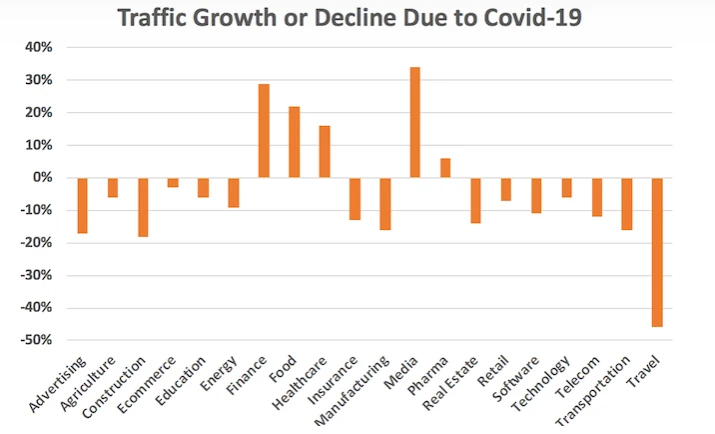The COVID-19 shutdown has turned the business world upside-down for the foreseeable future.
Because of the shutdown, businesses around the globe have had to revamp their approach to marketing and sales across the board.
It’s uncharted territory for pretty much every company in existence.
But that doesn’t mean it’s impossible to continue moving forward.
In truth, the organizations that are able to switch gears during this crisis are the ones who will survive and thrive through it.
To help your team make this pivot, Leadfeeder’s CMO, Andy Culligan, assembled a team of sales and marketing specialists to discuss how their companies are paving the way.
In this webinar, you’ll hear from:
Declan Mulkeen, CMO at Strategic IC, who discusses the state of account-based marketing (ABM) during COVID-19.
Alexander Low, Professional Services Lead at DLAignite, who helps you get started with social selling.
Will Brightling, Head of Sales and Partnerships at SaaStock, who talks about the role virtual events will play throughout the shutdown (and beyond).
Aaron Ross, Co-CEO at Predictable Revenue, as he discusses outbound sales strategies during the shutdown.
The panel then discusses some key questions brought up by the webinar’s live audience.
If you don’t have the time to check out the whole webinar right now, don’t worry: It’ll be there when you’re ready.
For now, here’s a sneak peek at what to expect.
Watch the webinar replay here.
Note: Need to streamline your sales and marketing efforts? Sign up for free Leadfeeder's 14-day trial to learn how to align your sales and marketing teams.
Account-based marketing during COVID-19, with Declan Mulkeen
According to Mulkeen, there are three key things you need to do as you adjust your approach to ABM during the shutdown:
Review your Ideal Customer Profile, or ICP
Audit your sales triggers
Activate your data
In looking at your ICP, there’s a decent chance that your key target personas aren’t buying (or aren’t buying as much) at the moment.

Still, as Mulkeen explains, “There’s always going to be an opportunity in any downturn.”
Though your former ICP may not be as active as they once were, there are likely consumers who are in need of your services now more than ever before.
Your first order of business, then, is to identify these individuals and start figuring out how to best serve them.
Mulkeen makes it clear:
“Think about your ICP. Think about the relevancy. And think about how you need to adjust it in these times.”

Once you know who your new target audience is, you need to know what triggers them to take action—and to make purchases.
Mulkeen advises that your team run through a gauntlet of questions, such as:
What is it that actually drives a sale?
What are you looking to monetize?
What drove revenue over the last 12 months?
What conversations drove revenue?
What pain points were clients talking to you about over that period?
The biggest question to ask yourself, though:
Are the answers to these questions still accurate today? If they are: Great! This will give you a clear idea of how to approach your still-active customers moving forward.
If things have changed, well…
Digging into the answers to these questions will help you correct course and start heading in the right direction.
Which brings up the importance of collecting new and up-to-date data during these turbulent times.
From internal first-party data (such as website visits and behaviors) to third-party intent data, it’s vital that you stay current with the goings-on within your industry and your target audience.
From there, it’s a matter of taking what you’ve learned, and applying it to your adjusted ABM processes.
Here’s Mulkeen again: “We’ve found that, if you can actually combine your first-party data with third-party data, and then actually run campaigns based on the hard data, you’ve got a far greater chance of actually driving conversations and driving pipeline.”
Social selling during COVID-19, with Alexander Low
Next, the focus turns to social selling expert Alexander Low.
Here, Low talks about the importance of using social media to discover, connect with, and begin nurturing sales prospects.
As Low points out, a good chunk of the B2B buying process happens digitally as it is.
Needless to say, the major shift to digital operations due to COVID-19 means your brand may have even more opportunities via social media.
The goal of social selling is to ultimately make the decision to purchase a no-brainer for your prospects.
Low explains:
“If you make it easy for someone to buy from you, they are more likely to buy from you, there is likely to be a higher deal value, and that relationship is going to remain longer.”

Low then shows exactly how he and his team approach social selling on LinkedIn.
Your first task is to flesh out your social media profile to clearly and effectively communicate your brand’s value.

That is, you want to communicate your brand’s value in the eyes of your target audience.
As Low says, your audience “doesn’t want to see how good you are at making sales or hitting quota. They want to understand what it is you can do, and how you can help them.”
You’ll then need to focus on discovering and curating content that your target audience is likely to engage with—or has already engaged with.
In turn, you can like, share, and comment on these posts in order to get on your audience’s radar. You can even engage in conversation with them via the comments section, as well.
You can then bring the conversation to your other channels to keep the prospect moving toward conversion.
Event marketing during COVID-19, with Will Brightling
The discussion then moves toward the topic of event marketing—which, as Will Brightling explains, is one of the hardest-hit industries in the world at the moment.
The cancellation of live events around the world has also made one thing crystal clear:
Industry events and conferences provide a ton of opportunities for SaaS companies looking to spread brand awareness and engage with potential customers.
Unfortunately, brands that had relied on live events for these purposes have been left scrambling. Companies have had to slash their marketing budgets, and figure out a way to replace the leads and revenues generated by their events pipelines.
As Brightling explains.
“People (and teams) are exploring virtual conferences, and exploring webinars to drive brand engagement and lead capture.”

For those looking for virtual events and conferences to attend, Brightling suggests you look to those your team has attended in the past.
If an event has gone digital for the time being, you definitely want to consider attending.

For one thing, you’ll likely have a much larger—and more widespread—audience than when tied to a physical location. Virtual events are more likely to draw a more targeted audience, as well.
(Not only that, but attending virtual events is inherently much more cost-effective than attending physical ones.)
But:
Because virtual conferences are likely to become more common, your brand will need to differentiate itself from the run-of-the-mill events that your audience will quickly tire of.
So, if you’re set on attending virtual events to spread brand awareness:
Get creative.
Figure out how your brand can provide value to your target audience despite not being in the same physical location.
Go beyond the lecture-style conference. Dig deep to provide a digital experience your audience won’t soon forget—and that places your brand at the forefront of their minds.
As for the future of event marketing?
Brightling predicts that, once the shutdown ends, brands will start taking a hybrid approach of sorts.
Moving forward, the goal will be to merge the best of both live and digital worlds.
This will allow teams to focus on high-quality leads and keep costs down—all while providing an innovative and unique experience to their target audience.
Outbound marketing during COVID-19, with Aaron Ross
As the conversation turns to the subject of outbound marketing, Aaron Ross reiterates two key messages:
What worked before won’t necessarily work now
You need to revisit your persona profiles and your brand’s value proposition
Ross explains that “a lot may or may not have changed in the last month. Even if the customers are the same, then problems and messaging may be different at this point.”
His advice?
Talk to your customers.
Take the time to understand where they’re at, what their concerns are, and what they need from you.
From there, develop unique, valuable, and branded messaging and content that hits the nail on the head.
(Note: As Ross points out, you also want to avoid creating branded messages around “these uncertain times,” and any of the other faux-empathetic statements we’ve seen from brands in the past two months.)
Ross talks about the idea of commoditizing your content, not your brand:
“The content in general is a bit of a commodity. What’s not a commodity, what can’t be copied, is you and your voice, whether it’s your company’s voice, or yours as a person.”

The focus of your outbound efforts should be on humanizing your brand, and humanizing your customers—and being there for them when they need you the most.
As for your approach to outbound content creation, Ross suggests three key tips:
Make it short
Make it easy to read and understand
Make it actionable
With so much uncertainty and upheaval going on around the globe, your audience will appreciate a quick-hitting, empathetic message that they can immediately put to use.
If you can manage to cut through the noise and make your brand’s voice and value heard loud and clear, you’ll have no trouble forging long-lasting relationships with your new customers.
Discussion panel questions
The second half of the webinar has the panel come together to answer and discuss a number of questions posed by the live audience, such as:
Should you be selling during COVID-19?
How do you better align marketing and sales during the shutdown?
What social selling channels should you focus on during COVID-19 and beyond?
What overall marketing channels are most active?
When and how should you begin planning to get “back to normal”?
With so much insight packed into such a short time period, your best bet is to check out the webinar in full.
Which you can do right here:
https://www.youtube.com/embed/JITgd8LAmFM Have anything to add to the discussion? Any questions that our panel could dive deeper into?
Leave a comment on the video and let us know.
Also, be sure to check back in the near future, as we’ll continue to support you and your team as you weather the storm and continue to grow your business through these turbulent times.
Note: Need to streamline your sales and marketing efforts? Sign up for free Leadfeeder's 14-day trial to learn how to align your sales and marketing teams.
Now that you're here
Leadfeeder is a tool that shows you companies that visit your website. Leadfeeder generates new leads, offers insight on your customers and can help you increase your marketing ROI.
If you liked this blog post, you'll probably love Leadfeeder, too.
Sign up


![Outbound Sales During Covid-19: How to Adapt to Yield Long Term Success [Webinar Recap]](http://images.ctfassets.net/plii0v5gbc4s/3aP8ba3vrRvm94kQV3bmoI/4b7f933244e666cc7a85ef47c16d45a6/outbound-sales-covid19-webinar-header.png?w=686&q=80)




